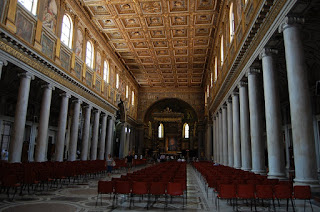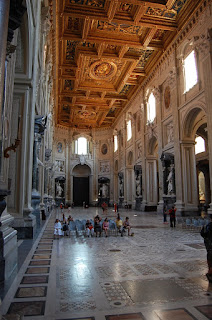The geography of the below itinerary was partially affected by when the churches were open (several of them had a big gap in the early afternoon when they were closed), so if the order makes no sense, that's why. I bought a day pass for the subway today, so I had the luxury of riding the trains whenever I wanted.
The first church on my list was Santa Maria della Vittoria, only a couple of blocks away from my new location near the Termini station and home to Bernini's Ecstasy of Saint Theresa. When I first walked into the church, I was surprised at its rather intimate scale - I think the nave was only about three bays in depth. Also, I was completely overwhelmed by the decoration, a Baroque riot of gilding, stucco, and colored marble on every surface:

I came to this church to see the Bernini side chapel, but I found myself overcome just standing in the nave and taking everything in. If there's one major revelation for me during this trip, it's that I'm a much bigger fan of multimedia church and palace decoration than I thought I would be. Wherever I go, I find myself staring up.
And then of course, there was the Ecstasy of Saint Theresa:

Most of the other people in the church were there just for this main event, and the flashbulbs were going off everywhere. I took some time to read the English account of Saint Theresa's vision that is provided on a notecard in front of the chapel, rather titillating in its florid language, and also appreciated the illusionism of the relief panels on either side of the main sculpture (visible at the right in the photo above). I feel tremendously spoiled, being able to see so many of the Bernini works that I've idolized for so long.
From Santa Maria della Vittoria, it was only a short walk to San Carlo alle Quatre Fontane, one of the greatest works of Borromini, Bernini's chief rival in Baroque architecture. Over the past week, I've talked to many other travelers who have raved about this church, so I was excited to visit it for myself. I don't have a good picture of the exterior facade, because the church is located at the corner of a very busy intersection of two narrow streets, filled with speeding motorcycles (have I mentioned that the motorcycle drivers in Rome are terrifying and incredibly irritating?). The interior is a gorgeous, light-filled space with a clever interplay between concave and convex surfaces:

This was also a pretty small church by Rome's standards, and not easy to photograph without special lenses. The clean, white marble used throughout the interior was quite a contrast with the heavy polychromed interior of Santa Maria della Vittoria, and in some ways it made me think of early American church interiors.
I did manage to get a pretty good photograph of the dome of this oval-shaped building:

I really loved the arrangement of shapes in the coffered ceiling - usually, you only see one type of shape, be it squares or circles or other polygons, but here, octagons, hexagons, squares and crosses combine in a wonderfully intricate ceiling.
After stopping for a leisurely lunch, I headed down to Santa Maria Maggiore, once again on foot. With its fifth-century plan, this church provided a much different feel and a much more massive scale than the previous two churches:

The most treasured decorations are the mosaics along the nave walls and decorating the triumphal arch at the east end, and they date from 440 AD. This is rather outside my area of expertise, but they sure were purdy, and sparkly. I was rather wishing that some of my birding family members were with me, because I really could have used a pair of binoculars, as the particulars of the mosaics are difficult to see.
My visit to Santa Maria Maggiore was somewhat marred by the fact that there was someone in the church doing who knows what with an organ - playing a few drawn-out notes that made up a creepy atonal melody, calling "EEEE-yup" and then repeating the process again. I don't know whether this was tuning, or an organ lesson for a person who didn't know how to play, or what, but the effect was creepy and unsettling. I was kind of glad to get out of there, because I almost felt like it was giving me indigestion.
One other note from Santa Maria Maggiore was that I passed by the tomb of Bernini:

After seeing so many fabulous tombs designed by Bernini, it was interesting to see that his own tomb consisted only of an inscribed slab. I maintain that I much prefer to visit an artist's work than his body, but I may have had a few thoughts of thanks for all the great times while looking at this humble monument.
Outside the church, I had a chance to enjoy a bit of spolia:

This massive column was originally a part of the Basilica of Maxentius, and is one of many examples throughout Rome of architectural parts reappropriated from imperial monuments.
I had no problems getting a good photograph of the facade of the next church:

This is the Lateran, the oldest Christian basilica in the world, originally dating to 314 AD, although you wouldn't know it to look at it. The church has been remodeled so many times that it's very difficult to get a hint of the early Christian basilica that it once was:

I took this photograph while standing in the transept, where I think the original basilica must have ended. Overall, I was very disappointed in the lack of aura that I felt here - Santa Maria Maggiore does a much better job of evoking the early church.
From the Lateran, I took a quick detour from my church tour to see a nearby Roman monument:

The Tomb of the Baker Eurysaces! This wonderfully strange little monument is the subject of an enlightening article by Lauren Petersen, one of my advisors at Delaware, and a battleground for discussions over what has been called "freedman art" in the Roman art history community. I really enjoyed seeing it in person - it's on a much more human scale than I thought it would be, and I was able to make out most of the details quite clearly. Now that I've seen it, I definitely find it odd that so many scholars want to label it as garish or ostentatious - I don't think it would have seemed so out of place in its original context.
Back to churches! I hopped back on the Metro, and made my way up to San Andrea al Quirinale, almost entirely designed by Bernini, and not too difficult to photograph from the outside:

Inside, however, I think I would have needed a much different set of lenses and a tripod to do any justice to the space, which is ovoid like Borromini's San Carlo alle Quatre Fontane but oriented in a different direction, with the shortest distance being between the main entrance and the altar:

The churches by Bernini and Borromini are separated by only a few hundred yards, and they present a master class on different styles of Baroque decoration, with Bernini's focus on color and texture and Borromini's emphasis on shape and contour. What a treat it was to visit both of these churches in the same day.
Winding down my day with one last stop, I headed up to the Piazza del Popolo:

Here is the piazza around 5pm, at the end of a rather gorgeous day - the heat wave has broken a bit for the time being, and I hope it stays that way for a while.
My focus was on the church of Santa Maria del Popolo, once again a completely different aesthetic experience, this time a bit heavier and more focused on the beauty of plain masonry that some of the earlier churches:

The main reason I visited this church was to see the two works by Caravaggio in the Ceraci chapel, his Conversion of St. Paul and Crucifixion of St. Peter. I wasn't able to take pictures inside the chapel, and this time I was rather glad, because I think it would have taken away from the experience if everyone had been snapping photographs. As it was, this was my first opportunity on this trip to look at works by Caravaggio that were perfectly lit to avoid glare, easy to access, and without the pressure of too much crowding. I took the opportunity to linger for as long as I liked.
Here is a view of that side chapel as seen from the nave, and I think it's actually rather fitting that it leaves an air of mystery about the experience:

I left the church feeling very solemn.
That was the end of my day today, and in the next few days, this story will have another protagonist - a certain tall, dark-haired, merry-eyebrowed gentleman who likes to do things like this:

I'll be leaving early tomorrow morning to meet him at the airport, and I can't wait!
No comments:
Post a Comment